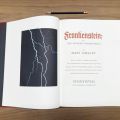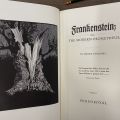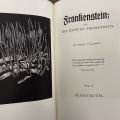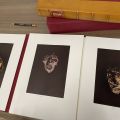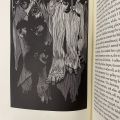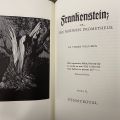During the Spring 2023 semester, Special Collections & Archives collaborated with Dr. Colleen Tripp's English 630, "Modern Monsters: Then & Now." Students in the class selected items from our collections of pulps, comics, and horror stories, then authored a series of blog posts in which they examined visual and other representations of the monstrous in the texts they chose. This is the seventh post of eight in the series.
Commonly referred to as the first science fiction novel, Mary Shelley’s Frankenstein proves to be a groundbreaking, terror-inducing narrative that highlights and develops numerous Gothic elements. From its mad scientist trope to its iconic monster, Shelley’s Frankenstein has had a profound impact on the Gothic mode.1 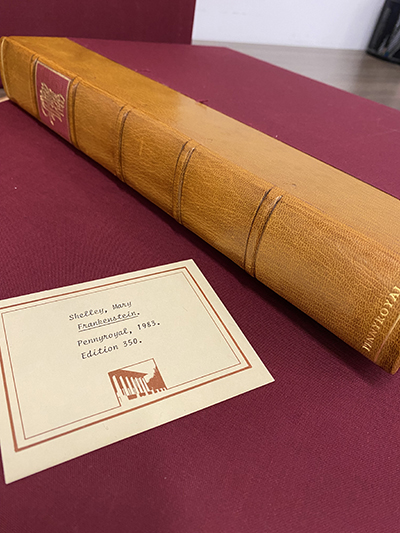 Since its original publication in 1818, many editions of the novel have been published across both English and American presses. In fact, the most widely read edition of Frankenstein was published in 1831 and featured some alterations from the original 1818 text.2 There’s an ongoing debate amongst scholars as to the preferred edition, with some arguing that the 1831 edition steers away from Shelley’s original intent. Regardless, the influence of Shelley’s novel is not up for debate, as its tropes and themes still resonate throughout literature and culture today.
Since its original publication in 1818, many editions of the novel have been published across both English and American presses. In fact, the most widely read edition of Frankenstein was published in 1831 and featured some alterations from the original 1818 text.2 There’s an ongoing debate amongst scholars as to the preferred edition, with some arguing that the 1831 edition steers away from Shelley’s original intent. Regardless, the influence of Shelley’s novel is not up for debate, as its tropes and themes still resonate throughout literature and culture today.
Special Collections & Archives houses a limited edition of Frankenstein that was published in 1984 by Barry Moser’s Pennyroyal Press. With only 350 copies ever printed, this version of Frankenstein is quarter bound with leather and features Barry Moser’s vivid wood engravings alongside Shelley’s original 1818 text. Included with the book is a portfolio with copies of all of Moser’s wood engravings. Known as a master wood engraver, Moser utilizes the oldest printing form of wood cutting to create his works of art and capture the dark and terrifying elements of Shelley’s novel. Moser’s dark art style depicts the moral quandaries of existence within Victor Frankenstein’s monster alongside his transfiguration and suffering, which terrifyingly turns out to be more human than monstrous.
This Pennyroyal edition of Frankenstein features a bold frontispiece titled, “A Stream of Fire.” The frontispiece is a wood engraving of lightning, which is the very first image that introduces the novel. Opening the narrative with a bold engraving of lightning establishes a dangerous and eerie setting that has destructive potential, just like Victor Frankenstein’s experiments. Although it is a natural occurrence, lightning instills a sense of unease and fear in humans, which are emotions frequently experienced within the Gothic mode. Evidently, Moser wishes to manifest these sensations in the audience from the onset. Each subsequent volume will also feature a prominent wood engraving related to the natural world.
The three volumes within this edition of Frankenstein present three wood engravings that visually and metaphorically represent the moral quandaries of existence and the psychological terror that ensues. As the novel progresses, the wood engravings reflect the moral reflection that arises from an individual’s arbitrary existence, which leads to a psychological terror predominantly featured in the Gothic. The three wood engravings are titled, “The Blasted Stump,” ‘The gay apparel of summer,’ and “A Blasted Tree.” All three images depict nature, with the first and last images featuring destruction. Both “The Blasted Stump” and “A Blasted Tree” portray a tree split in half, which represents Frankenstein’s monster’s inner conflict of existence as he carefully navigates the boundaries of humanity and monstrosity. The division between these two states of existence are depicted as violent and destructive as the monster struggles to belong. On the other hand, “The gay apparel of summer,” which can be found at the beginning of Volume II, represents the hope that the monster may have in a peaceful existence outside the boundaries of humanity. However, given the return to destruction in the third image, Frankenstein’s monster never successfully bridges the monstrous with the human and is destroyed as a result.
 Alongside all three of these wood engravings is the quote “Did I request thee, Maker, from my clay / To mould me man? Did I solicit thee / From darkness to promote me?—” This quote, which is from John Milton’s Paradise Lost, captures Frankenstein’s monster’s inner dilemma with his own existence: How should he lead a life that he did not ask for? The real terror lies in the realization that his experience is in fact not monstrous, but human in nature. As Jeffrey Jerome Cohen argues in his “Seven Theses,” “monsters are our children,” who “bear…human knowledge,” and “ask us why we have created them”.3 Thus, Frankenstein turns monstrosity on its head and equates it with humanity, blurring the lines between what is monstrous and what is human.
Alongside all three of these wood engravings is the quote “Did I request thee, Maker, from my clay / To mould me man? Did I solicit thee / From darkness to promote me?—” This quote, which is from John Milton’s Paradise Lost, captures Frankenstein’s monster’s inner dilemma with his own existence: How should he lead a life that he did not ask for? The real terror lies in the realization that his experience is in fact not monstrous, but human in nature. As Jeffrey Jerome Cohen argues in his “Seven Theses,” “monsters are our children,” who “bear…human knowledge,” and “ask us why we have created them”.3 Thus, Frankenstein turns monstrosity on its head and equates it with humanity, blurring the lines between what is monstrous and what is human.
Featuring many wood engravings of human and monstrous body parts, this book visually explores the piecing together of foreign, yet familiar objects to create a sense of the uncanny. Within the book, there are a series of portraits of Frankenstein’s monster that portray his decaying face consumed by darkness. According to R. Michelson Galleries, Moser placed chicken skin on a skull and left it out to decay to capture the essence of his artistic rendering of Frankenstein’s monster.4 The result is a face that is strikingly fearful, yet remotely familiar, for it still resembles a human skull. Sigmund Freud refers to this sensation as the uncanny since terror arises from the recognition of the familiar within the seemingly foreign. Similarly, page 48 features a wood engraving of hanging body parts titled, “Victor’s Midnight Labors.” When creating his monster, Victor Frankenstein scavenged and pieced together human body parts to create something new and unfamiliar. As disturbing and unappealing as the final product seems, the monster is still something recognizable to the human eye for it is made up of familiar pieces. Thus, Pennyroyal’s Frankenstein expands on the boundaries between the familiar and foreign, the human and the monster, that Shelley’s original work envisioned.
1. Tripp, Colleen Marie. Introduction to the Gothic. Jan. 2023, https://prezi.com/view/7cI2RWBqpJM2ggFoTKdd/. Prezi Presentation.
2. “The Many Editions of Frankenstein.” University of North Georgia Press, 25 Oct. 2018, https://blog.ung.edu/press/editions-of-frankenstein/.
3. Cohen, Jeffrey Jerome. “Monster Culture (Seven Theses).” Classic Readings on Monster Theory: Demonstrare, Volume One, edited by Asa Simon Mittman and Marcus Hensel,
Arc Humanities Press, 2018, pp. 44-54.
4. “The Pennyroyal Press: Frankenstein or, The Modern Prometheus.” R. Michelson Galleries, https://www.rmichelson.com/artists/barry-moser/the-pennyroyal-press/frankenstein/.



